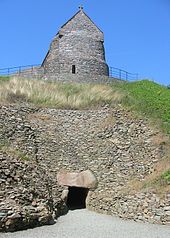Megalithic systems of the Channel Islands
The megalithic complexes of the Channel Islands consist of 25 relatively well-preserved of the more than 110 verifiable large stone graves , plus menhirs and stone boxes . Many facilities were excavated or registered by Frederick Corbin Lukis (1788–1871), an amateur archaeologist, in the mid-19th century . Some were only discovered under dunes in the 20th century . Neolithic monuments are an expression of the ideology of Neolithic societies. Their development and function depend on social development.
The archipelago belonging to the British crown possession was separated from the French mainland by the post-glacial sea level rise ( Jersey around 4000 BC). The first systems were built a little later.
Dolmen with corridor



One category of the very varied systems on the islands are 10 well-preserved dolmens with a walkway on the two large channel islands . Seven of these dolmens are in Jersey and three in Guernsey . There are also some more or less disturbed (La Pierre de la Fêtelle, La Table des Marthes, Le cinq Pierres, Le Trépied) or reconstructed (Le Couperon) systems. Even on the island of Herm , which is only two square kilometers in size, there are - albeit heavily destroyed - installations (Roberts Cross) and some menhirs. As far as can be proven, almost all megalithic systems on the Channel Islands were located in round hills with low, short or long corridors. Some of them have side chambers (La Pouquelaye de Faldouet, Le Dehus).
Passage Tombs on Jersey:
- Dolmen du Couperon
- La Pouquelaye de Faldouet
- La Hougue Bie
- La Hougue des Géonnais
- La Sergenté
- Le Mont de la Ville (now in England)
- Dolmen du Mont Ubé
- Les Monts Grantez
- La Hougue Boëte is an aisle-free dolmen.
Passage Tombs on Guernsey:
Le Dehus, with a menhir in the chamber, and La Hougue Bie are the most famous structures in the archipelago. They are among the most beautiful prehistoric monuments in Europe. The La Varde dolmen on the golf course of L'Ancresse is the largest with a length of ten meters, four meters wide and a height of over two meters. The finds there come from a 1500 year period of use.
Les Fouaillages (on Guernsey) is unique. The aisle-free dolmen in the triangular edging was found under a dune in 1979. It is considered to be the oldest system in the Channel Islands. The older Neolithic complexes, the largest stones of which weigh 20 tons, date from around 3,800 BC. Chr.
The small islands:
- Les Pourciaux, dolmen on Alderney
- Megalithic sites on Herm Grand and Petit Monceau, Robert's Cross and The Common Herm
- Little Sark Dolmen on Sark
Stone boxes
The most important stone box of the archipelago is in a small stone circle , which probably represents the curbs of its former hillside, in La Ville ès Nouaux on Jersey. It stands next to the reconstructed dolmen and was also covered by a dune. The stone box of Hougue des Platons was moved to the Hougue Bie Museum.
Menhirs
There are several menhirs that still stand at their original location, including
- La Dame Blanche
- La Longue Rocque (the great menhir; 3.5 meters high)
- Little Menhir (the small menhir: 1.7 m high)
and short rows of stones (Les Trois Rocques). Other menhirs were moved, for example one in the church of St. Peter in the Wood.
Statue menhirs
A peculiarity are the two next to Chapel Down on the Scilly island of St. Martin’s northernmost statue menhirs in Western Europe on Guernsey, the Gran 'Mère du Chimquière at the church of Saint Martin and the only 2.5 km away in the hinterland of the island capital Saint Peter Port located about two meters high, in the open standing Castel Church menhir . It was found in 1878 under the floor of the choir of the 6th century church.
literature
- Heather Sebire: The Archeology and Early History of the Channel Islands . 2005; ISBN 0-7524-3449-7 .
- Mark Patton: Megalithic transport and territorial markers: evidence from the Channel Islands . In: Antiquity 66 (251), 1992.
- David E. Johnston: The dolmen of Les Pourciaux, South Alderney. The excavations of 1838, 1858 and 1973 In: Report and Transactions Volume 19 (3) 1974
Web links
- Descriptions of the megalithic complexes on the Channel Islands (English), with photos
- Description of the Gran 'Mere du Chimquiere (English )
Individual evidence
- ↑ J. Müller In: Varia neolithica VI 2009 p. 15






